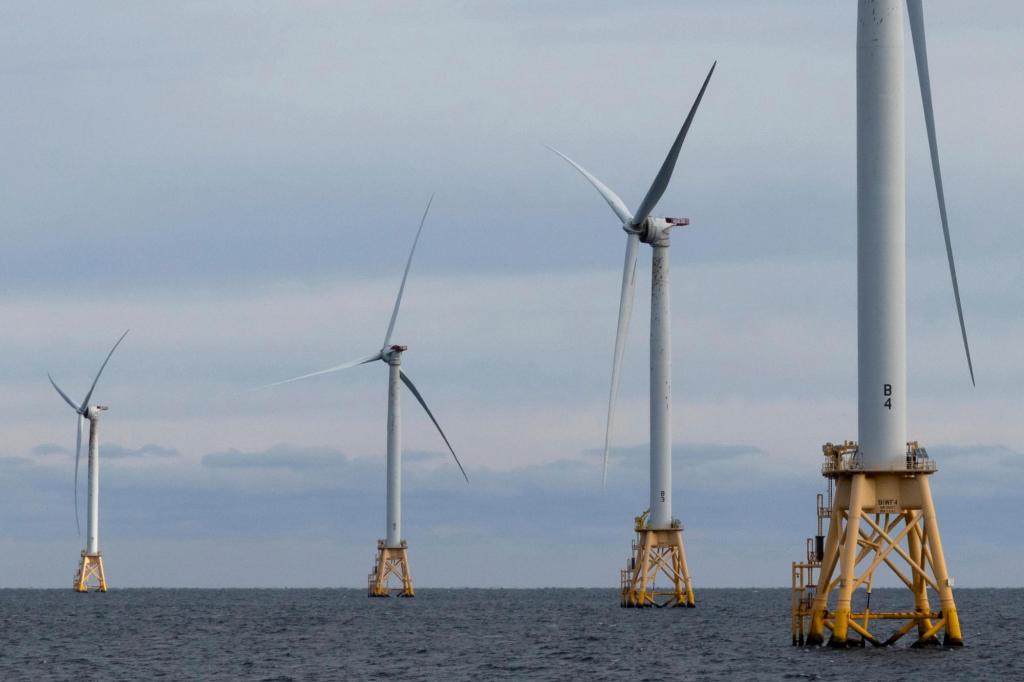
By JENNIFER McDERMOTT and MATTHEW DALY
WASHINGTON (AP) — The Biden administration is shelling out billions of dollars for clean energy and approving major offshore wind projects as officials race to secure major climate initiatives before President Joe Biden’s term comes to an end.
Biden wants to establish a legacy for climate action that includes locking in a trajectory for reducing the nation’s planet-warming greenhouse gas emissions. Former President Donald Trump has pledged to rescind unspent funds in Biden’s landmark climate and health care bill and stop offshore wind development if he returns to the White House in January.
Vice President Kamala Harris, who became the Democratic nominee after Biden dropped from the race this summer, has said she will pursue a climate agenda similar to Biden’s, focused on reducing emissions, deploying renewables and creating clean energy jobs.
Announcements of major environmental grants and project approvals have speeded up in recent months as White House Deputy Chief of Staff Natalie Quillian said Biden is “sprinting to the finish” and delivering on promises to promote clean energy and slow climate change:
The Environmental Protection Agency made $20 billion from a federal “green bank” available this summer for clean energy projects such as residential heat pumps, electric vehicle charging stations and community cooling centers.
The Bureau of Ocean Energy Management approved the nation’s 10th large offshore wind farm, the Maryland Offshore Wind Project, in September, reaching the halfway mark for Biden’s goal of 30 gigawatts of offshore wind energy by 2030. On Oct. 1, the agency gave a key approval to an offshore wind farm project in New Jersey.
In the past month alone, the Energy Department has made six announcements of a billion dollars or more, including more than $3 billion for battery manufacturing projects and a $1.5 billion loan to restart a nuclear plant in Michigan. And just last week, Biden set a 10-year deadline for cities to replace their lead pipes, with $2.6 billion available from the EPA to help communities comply.
Besides the climate law, formally known as the Inflation Reduction Act, Biden is seeking to spend billions in projects approved under the bipartisan infrastructure law in 2021 and the 2022 CHIPS and Science Act. The $1 trillion infrastructure law includes cash for roads, bridges, ports and more, while the CHIPS law aims to reinvigorate the computer chip sector in the United States through tens of billions of dollars in government support.
Energy experts say the rush of announcements is not surprising.
“I’m sure the prospect of a change in the White House, and a change in agency leadership, is creating an increased sense of urgency to get those programs stood up and implemented,” said Trevor Houser, a partner at the Rhodium Group research firm.
There’s an undeniable pressure to lock in as many energy transition benefits as possible before the end of the year, said Matt Lockwood, vice president of strategic market areas and accounts at DNV, which advises companies on energy issues. It’s been two years since the climate legislation passed, so federal agencies are starting to churn through these transactions at a faster pace, he said.
The climate legislation put the country on a path to cutting greenhouse gas emissions to try to meet targets in the Paris climate accord. The investments are expected to reduce U.S. emissions by about 40% by 2030.
A new analysis by global consultant Baringa found that Trump would stall the transition from fossil fuels, though by how much would depend on whether the House or Senate is controlled by Democrats who could temper climate rollbacks. Trump, if unrestrained, could permanently alter the trajectory of the energy transition by repealing the climate legislation, substantially slowing renewable rollout and leaving the U.S. wedded to coal and gas for far longer, said Caspian Conran, an economist at Baringa who co-authored the analysis published Wednesday.
As vice president, Harris cast the tiebreaking vote on the Inflation Reduction Act, which was approved with only Democratic support. As a senator from California, she was an early sponsor of the Green New Deal, sweeping proposals meant to swiftly move the United States fully to green energy.
At a presidential debate last month, however, Harris boasted that the administration has overseen “the largest increase in domestic oil production in history because of an approach that recognizes that we cannot over-rely on foreign oil.”
Trump’s policies, meanwhile, could raise emissions by about 12% by 2030 compared to those favored by Harris or Biden, Baringa’s report said, equivalent to roughly 660 million tons of carbon dioxide.
“This is a race against time to certain extent,” Conran said in an interview. “So even if you’re saying we’re delaying the transition (to clean energy) by five years, maybe that doesn’t seem like a lot. But actually that’s quite profound.”
The U.S. is the world’s second-largest emitter of planet-warming carbon dioxide. Baringa says Trump’s first-term policies caused emissions to rise 9%, while Biden’s policies lowered emissions by 11%.
Companies have announced about 340 major clean energy projects across the country in the past two years, according to E2, a nonpartisan environmental research group. Sixty percent of those, representing 82% of the investments and 69% of the jobs, are in Republican congressional districts despite unanimous GOP opposition to the law, E2 said.
Eighteen House Republicans, including several in close races for reelection, told the House speaker in August they want to protect energy tax credits in Biden’s climate legislation that are creating jobs. “Energy tax credits have spurred innovation, incentivized investment and created good jobs in many parts of the country – including many districts represented by members of our conference,” the lawmakers wrote.
To get the clean energy transition right, the U.S. needs to commit to it across election cycles, from one administration to the next, and through sessions of Congress, said Conrad Schneider, senior director at the Clean Air Task Force, an advocacy group.
“We’re trying to publicize the fact that (clean energy) is really beneficial for communities all over the country, whatever political geography,” he said. “And so we hope that will mean these programs can be sustained through any combination of electoral outcomes.”
McDermott reported from Providence, R.I.
The Associated Press’ climate and environmental coverage receives financial support from multiple private foundations. AP is solely responsible for all content. Find AP’s standards for working with philanthropies, a list of supporters and funded coverage areas at AP.org.
Originally Published:

















































